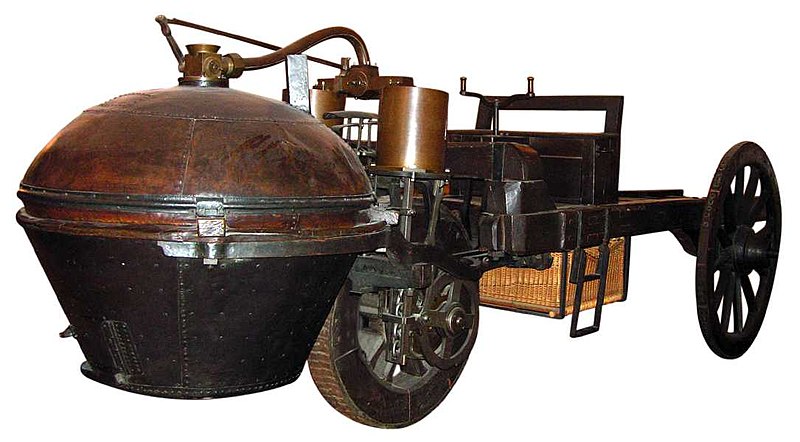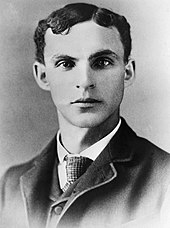
In 1649, Hans Hautsch of Nuremberg built a clockwork-driven carriage. The first steam-powered vehicle was designed by Ferdinand Verbiest, a Flemish member of a Jesuit mission in China around 1672. It was a 65-centimetre-long (26 in) scale-model toy for the Kangxi Emperor that was unable to carry a driver or a passenger. It is not known with certainty if Verbiest's model was successfully built or run.

Nicolas-Joseph Cugnot is widely credited with building the first full-scale, self-propelled mechanical vehicle in about 1769; he created a steam-powered tricycle. He also constructed two steam tractors for the French Army, one of which is preserved in the French National Conservatory of Arts and Crafts. His inventions were limited by problems with water supply and maintaining steam pressure. In 1801, Richard Trevithick built and demonstrated his Puffing Devil road locomotive, believed by many to be the first demonstration of a steam-powered road vehicle. It was unable to maintain sufficient steam pressure for long periods and was of little practical use.
The development of external combustion (steam) engines is detailed as part of the history of the car but often treated separately from the development of true cars. A variety of steam-powered road vehicles were used during the first part of the 19th century, including steam cars, steam buses, phaetons, and steam rollers. In the United Kingdom, sentiment against them led to the Locomotive Acts of 1865.
In 1807, Nicéphore Niépce and his brother Claude created what was probably the world's first internal combustion engine (which they called a Pyréolophore), but installed it in a boat on the river Saone in France. Coincidentally, in 1807, the Swiss inventor François Isaac de Rivaz designed his own "de Rivaz internal combustion engine", and used it to develop the world's first vehicle to be powered by such an engine. The Niépces' Pyréolophore was fuelled by a mixture of Lycopodium powder (dried spores of the Lycopodium plant), finely crushed coal dust and resin that were mixed with oil, whereas de Rivaz used a mixture of hydrogen and oxygen. Neither design was successful, as was the case with others, such as Samuel Brown, Samuel Morey, and Etienne Lenoir, who each built vehicles (usually adapted carriages or carts) powered by internal combustion engines.
In November 1881, French inventor Gustave Trouvé demonstrated a three-wheeled car powered by electricity at the International Exposition of Electricity. Although several other German engineers (including Gottlieb Daimler, Wilhelm Maybach, and Siegfried Marcus) were working on cars at about the same time, the year 1886 is regarded as the birth year of the modern car—a practical, marketable automobile for everyday use—when the German Carl Benz patented his Benz Patent-Motorwagen; he is generally acknowledged as the inventor of the car.
In 1879, Benz was granted a patent for his first engine, which had been designed in 1878. Many of his other inventions made the use of the internal combustion engine feasible for powering a vehicle. His first Motorwagen was built in 1885 in Mannheim, Germany. He was awarded the patent for its invention as of his application on 29 January 1886 (under the auspices of his major company, Benz & Cie., which was founded in 1883). Benz began promotion of the vehicle on 3 July 1886, and about 25 Benz vehicles were sold between 1888 and 1893, when his first four-wheeler was introduced along with a cheaper model. They also were powered with four-stroke engines of his own design. Emile Roger of France, already producing Benz engines under license, now added the Benz car to his line of products. Because France was more open to the early cars, initially more were built and sold in France through Roger than Benz sold in Germany. In August 1888, Bertha Benz, the wife and business partner of Carl Benz, undertook the first road trip by car, to prove the road-worthiness of her husband's invention.
In 1896, Benz designed and patented the first internal-combustion flat engine, called boxermotor. During the last years of the 19th century, Benz was the largest car company in the world with 572 units produced in 1899 and, because of its size, Benz & Cie., became a joint-stock company. The first motor car in central Europe and one of the first factory-made cars in the world, was produced by Czech company Nesselsdorfer Wagenbau (later renamed to Tatra) in 1897, the Präsident automobil.
Daimler and Maybach founded Daimler Motoren Gesellschaft (DMG) in Cannstatt in 1890, and sold their first car in 1892 under the brand name Daimler. It was a horse-drawn stagecoach built by another manufacturer, which they retrofitted with an engine of their design. By 1895, about 30 vehicles had been built by Daimler and Maybach, either at the Daimler works or in the Hotel Hermann, where they set up shop after disputes with their backers. Benz, Maybach, and the Daimler team seem to have been unaware of each other's early work. They never worked together; by the time of the merger of the two companies, Daimler and Maybach were no longer part of DMG. Daimler died in 1900 and later that year, Maybach designed an engine named Daimler-Mercedes that was placed in a specially ordered model built to specifications set by Emil Jellinek. This was a production of a small number of vehicles for Jellinek to race and market in his country. Two years later, in 1902, a new model DMG car was produced and the model was named Mercedes after the Maybach engine, which generated 35 hp. Maybach quit DMG shortly thereafter and opened a business of his own. Rights to the Daimler brand name were sold to other manufacturers.
In 1890, Émile Levassor and Armand Peugeot of France began producing vehicles with Daimler engines, and so laid the foundation of the automotive industry in France. In 1891, Auguste Doriot and his Peugeot colleague Louis Rigoulot completed the longest trip by a petrol-driven vehicle when their self-designed and built Daimler powered Peugeot Type 3 completed 2,100 kilometres (1,300 mi) from Valentigney to Paris and Brest and back again. They were attached to the first Paris–Brest–Paris bicycle race, but finished six days after the winning cyclist, Charles Terront.
The first design for an American car with a petrol internal combustion engine was made in 1877 by George Selden of Rochester, New York. Selden applied for a patent for a car in 1879, but the patent application expired because the vehicle was never built. After a delay of 16 years and a series of attachments to his application, on 5 November 1895, Selden was granted a US patent (U.S. patent 549,160) for a two-stroke car engine, which hindered, more than encouraged, development of cars in the United States. His patent was challenged by Henry Ford and others, and overturned in 1911.

In 1893, the first running, petrol-driven American car was built and road-tested by the Duryea brothers of Springfield, Massachusetts. The first public run of the Duryea Motor Wagon took place on 21 September 1893, on Taylor Street in Metro Center Springfield. Studebaker, subsidiary of a long-established wagon and coach manufacturer, started to build cars in 1897 and commenced sales of electric vehicles in 1902 and petrol vehicles in 1904.
In Britain, there had been several attempts to build steam cars with varying degrees of success, with Thomas Rickett even attempting a production run in 1860. Santler from Malvern is recognised by the Veteran Car Club of Great Britain as having made the first petrol-driven car in the country in 1894, followed by Frederick William Lanchester in 1895, but these were both one-offs. The first production vehicles in Great Britain came from the Daimler Company, a company founded by Harry J. Lawson in 1896, after purchasing the right to use the name of the engines. Lawson's company made its first car in 1897, and they bore the name Daimler.
In 1892, German engineer Rudolf Diesel was granted a patent for a "New Rational Combustion Engine". In 1897, he built the first diesel engine. Steam-, electric-, and petrol-driven vehicles competed for a few decades, with petrol internal combustion engines achieving dominance in the 1910s. Although various pistonless rotary engine designs have attempted to compete with the conventional piston and crankshaft design, only Mazda's version of the Wankel engine has had more than very limited success.
All in all, it is estimated that over 100,000 patents created the modern automobile and motorcycle.